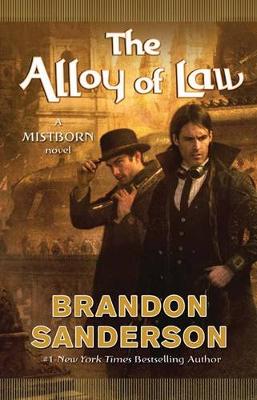Reviewed by Briana @ Pages Unbound on
Nonetheless, The Alloy of Law does have one wildly imaginative thing going for it: the book attempts to imagine what would happen to a fantasy world that actually progressed. Novel, right? It jumps from the pre-technology world of Mistborn to a version three hundred years later that has railroads, electricity, and—most importantly—new rules of magic. Strangely, I was unable to get as good of a grasp on these rules as I was on the old ones. Sanderson does spend a decent amount of time going over them, and describing how they work in numerous battle scenes, but for some reason they just come across as more nebulous—at least to me. The appendix might help clarify for some readers.
As far as characters go, Sanderson draws them as complex and life-like as ever. I worried at the beginning of the book that I wouldn’t particularly enjoy Wax as a protagonist. The story opens with his experiencing a devastating event, and for awhile it seemed as if that event were going to haunt him just a little too much. There’s a difference between having a psychological block one has to overcome and constantly brooding/harping on that block. However, as the book progresses, Wax develops a few more personality quirks that help round him out. And it is impressive to see that Sanderson can write both a middle-aged male and a sixteen –year-old female character with equal ease.
Wayne is a fantastic sidekick. (It took me a decent way through the book to realize that together, they are Wax and Wayne…like the stages of the moon.) He is both abrasive and charming, both brave and child-like. Perhaps occasionally annoying to hang out with in person, but definitely a pleasure to read about. The female member of the group/potential love interest has me slightly more torn. Marasi is talented, brave, and clever—basically the embodiment of the strong female character, balanced by the tendency to turn pale at the sight of blood. However, her tendency to spout crime/law statistics when nervous is irritating and seems unrealistic, and she has a penchant for suddenly possessing whatever skill is needed for her role in the plot. As an explanation: she learned it all at university.
The plot is generally past-faced, but, again, just not as wild as in Mistborn. Readers get a lot of stunningly visual fight scenes; Sanderson always writes as if he expects his novels to be made into movies. However, the motive behind everything just isn’t particularly…big. Just enough “revelations” are eventually made to justify the fact that this will also be made into a trilogy (next two books coming out 2015!), but I just don’t know if I care enough to keep reading. I probably will, because it’s Brandon Sanderson, and that means things do have a chance to get even crazier than I am currently envisioning, but the conclusion of The Alloy of Law just does not captivate me.
I did enjoy The Alloy of Law. It’s tightly written, has some great characters, and brilliantly imagine what the world would look like after Mistborn (including some great hints as to the religions and legends that have sprung up around the original characters). On a technical level, I think it’s a great fantasy novel. However, if I compare it to Mistborn, I’m slightly disappointed.
Reading updates
- Started reading
- 22 December, 2014: Finished reading
- 22 December, 2014: Reviewed
